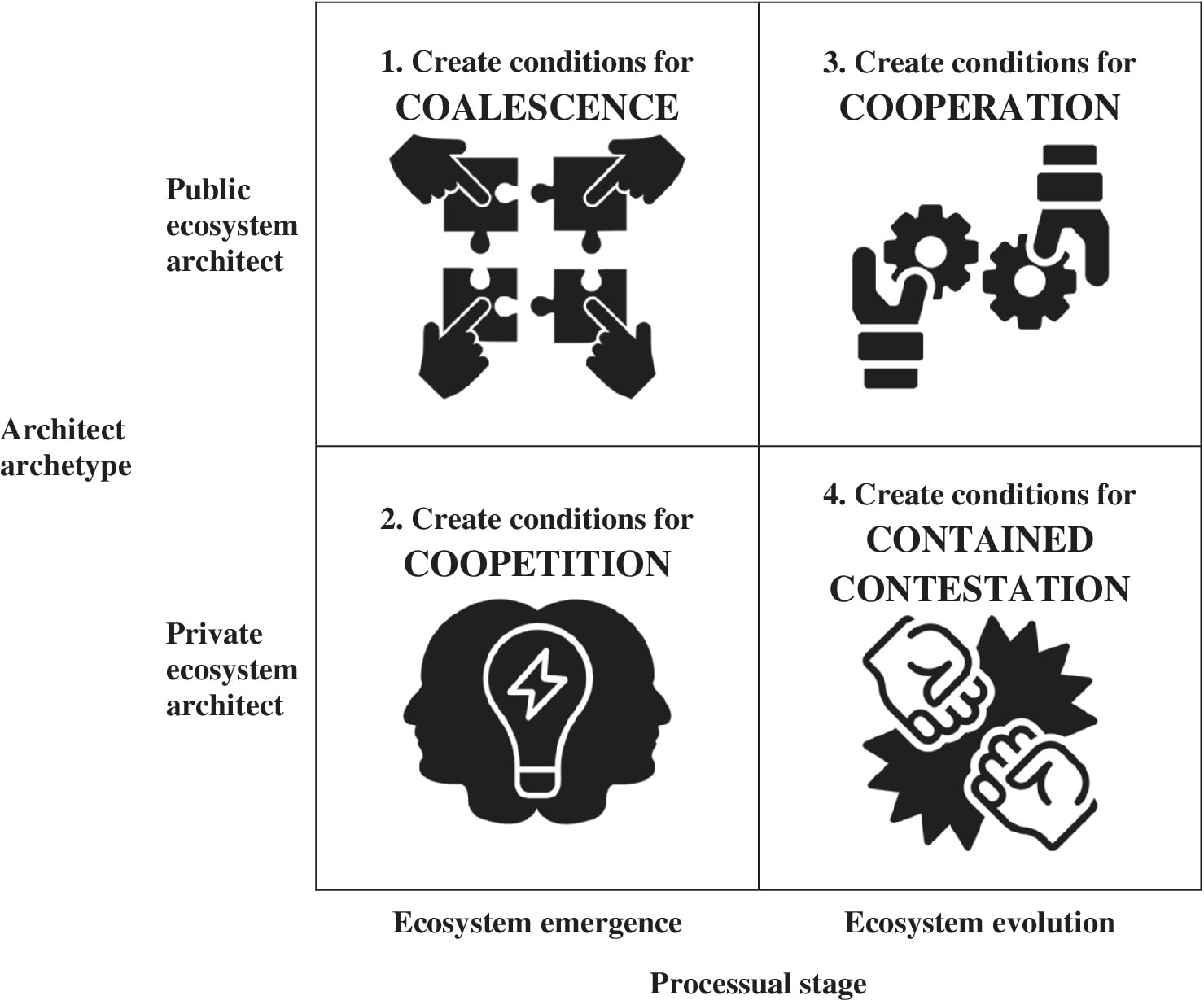What insights does strategy research offer to practitioners interested in nurturing the creation and ongoing development of a range of different types of ecosystems? In our introduction to an SMS Collection, we distill relevant findings and outline four strategies for public and private ecosystem architects to create conditions appropriate to their ecosystem and its stage of development.
Industry and civic leaders seeking to stay ahead of the curve for their businesses and constituents have turned their attention to the concept of ecosystems. It is unsurprising, then, that “ecosystems” have become increasingly prominent in academic and industry circles as they provide a framework for understanding the complex interrelationships between various actors, functions, and institutions. At its core, an ecosystem is a system of co-located elements that interact to support the creation and growth of new ventures, technologies, or business platforms. These ecosystems can range from entrepreneurial ecosystems, which tend to be sector and technology-agnostic, to business, innovation, and platform ecosystems, which focus on a particular firm, technology, or platform.
Ecosystem architects: Key players in the emergence and evolution of ecosystems
And while there is a growing understanding of ecosystems and their importance, there is an increasing need to understand better how ecosystems can be nurtured and developed effectively. As a result, we turn our attention to the role of ecosystem architects” – private or public sector actors who vested interests in the success of an ecosystem as a whole. Ecosystem architects include “civic leaders or firm CEOs who aim to bring into existence then nurture the ongoing expansion and development of an ecosystem as a whole, rather than for the narrow benefit of a single or few participants within the ecosystem.”
In our recent introduction to an SMS Collection, we reviewed key articles published in the journals of the Strategic Management Society. We distilled insights for ecosystem architect practitioners and outlined strategies that ecosystem architects can use to create conditions appropriate for their ecosystem and its stage of development.
We distinguish between public and private ecosystem architects in offering strategies for ecosystem architects. Public ecosystem architects are primarily interested in how entrepreneurial ecosystems create value for stakeholders without capturing it themselves. This is because they see much of the value created by an ecosystem as a public good. In contrast, private ecosystem architects are interested in both the creation and capture of value by stakeholders, including themselves.
Based on these differences, the four strategies that ecosystem architects can use to manage ecosystem dynamics are to create conditions for coalescence, coopetition, cooperation and contained contestation within ecosystems.
Strategies for managing ecosystem dynamics
For public ecosystem architects in emerging ecosystems, the focus should be on creating conditions for coalescence amongst ecosystem participants. This involves bringing diverse ecosystem actors together to form embryonic relationships, establish a shared identity, and develop mechanisms for interaction. To do this, public ecosystem architects can encourage new connections among ecosystem participants, facilitate dialogue and trust, empower other actors to create opportunities for connection, and role-model behaviors that build goodwill.
For private ecosystem architects in emerging ecosystems, the focus should be on creating conditions for coopetition amongst ecosystem players. As these ecosystems are typically anchored in specific industries or technologies, the connections between actors are more explicitly transactional in nature. Therefore, private ecosystem architects must create conditions that simultaneously encourage competition and cooperation among actors in the emerging ecosystem.
For public ecosystem architects in evolving ecosystems, the focus should be on creating conditions for cooperation within the ecosystem. This involves providing mechanisms that enable the maturation of cooperative relationships among actors, catalyzing ecosystem competitiveness and productivity, and fostering a culture of positive-sum thinking.
Finally, for private ecosystem architects in evolving ecosystems, the focus should be on creating conditions for contained contestation with the ecosystem. This involves establishing clear rules and guidelines for competition, creating a level playing field for all actors, and fostering a culture of mutual respect and collaboration.

Architects of electric vehicle ecosystems
The electric vehicle (EV) ecosystem has seen rapid growth in recent years, and ecosystem architects have played a critical role in driving this growth. Public ecosystem architects, such as governments and regulatory bodies, have created conditions for coalescence among ecosystem participants by establishing standards and regulations for EVs and charging infrastructure. They have also provided incentives and subsidies to encourage the adoption of EVs, and have worked to create a favorable policy environment for the industry to grow.
Private ecosystem architects on the other hand, such as EV manufacturers, have created conditions for coopetition and contained contestation within the ecosystem. They have collaborated with each other and with other stakeholders in the industry, such as battery manufacturers and charging infrastructure providers, to develop new technologies and products. At the same time, they have competed with each other to capture value in the market, driving innovation and improving the quality and affordability of EVs—all while seeking to develop the ecosystem as a whole.
Overall, the burgeoning success of the EV ecosystem has been impacted by the strategies adopted by public and private ecosystem architects.

The concept of ecosystems is a powerful tool for businesses and organizations looking to stay ahead in today’s competitive marketplace, and ecosystem architects play a critical role in their growth and development. Based on the stage of ecosystem development and the goals of ecosystem architects, we recommend strategies for driving the success of the ecosystems. With these strategies in mind, we believe ecosystem architects can create thriving and sustainable ecosystems that provide value to all stakeholders.
Our open-access full article provides more detail on the strategies ecosystem architects can adopt to unlock the potential of their ecosystems.
- Daymond, J., Knight, E., Rumyantseva, M., & Maguire, S. (2022). Managing ecosystem emergence and evolution: Strategies for ecosystem architects. Strategic Management Journal.



